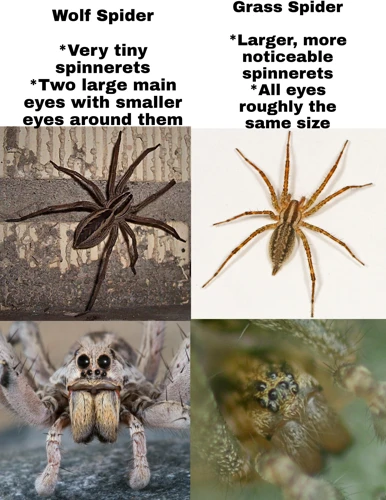Wolf spiders are a fascinating arachnid species found across the world. They are known for their agility, speed, and hunting prowess, making them a subject of interest for many researchers and enthusiasts. However, measuring the size of a wolf spider accurately requires a certain level of skill and precision. It can be a perplexing task for those new to spider measurements. Fear not, though, as this article will guide you through the process of measuring a wolf spider’s size accurately. From highlighting the tools and techniques required to tricks for accurate measurement, we’ve got you covered. So, if you’re ready to delve into the fascinating world of wolf spiders and learn how to measure their size with confidence, keep reading!
Why Accurately Measure a Wolf Spider’s Size?

Accurately measuring the size of a wolf spider is important for a number of reasons. Understanding the significance and implications of their size can aid in identification and provide insights into their behavior. Additionally, being able to differentiate between male and female wolf spiders based on size can reveal interesting information about their biology. In this section, we will explore the reasons why measuring a wolf spider’s size is beneficial. To learn more about how size impacts wolf spider hunting techniques or the potential environmental impact of their size, check out our articles on wolf spider size and hunting techniques and environmental impact of wolf spider size, respectively. For information on the variations in body size of male and female wolf spiders, head over to our article on male and female wolf spider sizes.
Identification Purposes
Knowing how to accurately measure the size of a wolf spider can be very useful for identification purposes. By measuring the spider’s body length, you can determine which species it belongs to, which in turn tells you more about its habitat, behavior, and potential venomousness.
The size of a wolf spider’s body can also be an indicator of its age, with younger spiders being smaller in size. This information can help researchers and enthusiasts better understand the spider’s lifespan and reproductive habits.
To further illustrate the importance of accurately measuring wolf spider size for identification purposes, take a look at the table below:
| Wolf Spider Species | Average Body Length (inches) | Max Body Length (inches) |
|---|---|---|
| Tigrosa helluo | 0.5 – 1.2 | 1.75 |
| Gladicosa pulchra | 0.4 – 1.0 | 1.25 |
| Lycosa carolinensis | 0.6 – 1.2 | 1.75 |
| Rabidosa rabida | 0.3 – 0.8 | 1.1 |
As you can see, even among different species of wolf spiders, there can be a significant variation in body length. Accurately measuring the spider’s size can help narrow down the species and aid in proper identification.
For more information on wolf spider body size variations, check out our article on Wolf Spider Body Size Variations.
For Better Understanding of Their Behaviour
Accurately measuring the size of a wolf spider is not only important for identification purposes, but it also helps in understanding their behavior. Wolf spiders are known for their hunting and defensive strategies, and their size plays a crucial role in how they interact with their environment and prey.
By measuring their size accurately, researchers and enthusiasts can gather data on how their size affects their hunting techniques, migration patterns, and reproduction habits. Larger wolf spiders, for example, are known to hunt at different times and in different environments than smaller ones. They may also have different mating behaviors.
Understanding the size of wolf spiders can help in conservation efforts, particularly if their habitats are being threatened. By studying the size and behavior of these spiders, experts can assess their potential impact on their ecosystems and develop strategies to protect them.
Measuring the size of wolf spiders accurately is not always an easy task, but with proper techniques and tools, it can be done effectively. In the following sections, we will discuss the necessary tools and techniques to measure their size properly.
Measuring Tools and Techniques

When it comes to accurately measuring the size of a wolf spider, it’s important to have the right tools and techniques. Measuring a spider’s size can be tricky, especially if it’s a particularly large or elusive specimen. That’s why it’s important to be properly equipped with the right tools and knowledgeable about correct measuring techniques. In this section, we will explore the various tools you will need to begin measuring wolf spiders, as well as the best techniques to use for obtaining the most accurate measurements possible. So, let’s get started!
Tools Required
When it comes to accurately measuring the size of a wolf spider, there are several tools that can be used to achieve this. These tools include:
| Tool | Description |
|---|---|
| Tape Measure | A tape measure is a flexible ruler that can be used to measure the length and width of a wolf spider. |
| Calipers | Calipers are used for precise measurements and can be used to measure the length and width of a wolf spider’s body. |
| Magnifying Glass | A magnifying glass can be used to closely examine the wolf spider’s eye arrangement and help determine its sex. |
| Digital Camera | A digital camera can be used to take photographs of the wolf spider, which can then be used to measure its body size later on. |
It is important to note that all of these tools are easily accessible and can be purchased at most hardware or pet stores. When measuring a wolf spider, it is important to be gentle and avoid injuring the spider in any way. Additionally, it is best to measure the spider while it is immobile to avoid any errors in measurement. With the right tools and techniques, accurately measuring the size of a wolf spider can be a relatively simple task.
Techniques for Measuring
To accurately measure the size of a wolf spider, you should use calipers and a ruler. Calipers will give you precise measurements of the spider’s body, while a ruler will measure its overall size, including its legs. Here are some techniques you can use to measure a wolf spider:
- Capturing the Spider: First, you need to catch the spider. You can do this with a glass jar or with a vacuum cleaner, but you need to be careful not to harm the spider.
- Restrain the Spider: Once you have caught the spider, you need to restrain it so that it doesn’t move around while you are measuring it. You can do this by placing it in a clear plastic container or by gently holding it with your fingers.
- Use Calipers: To measure the size of the spider’s body, use the calipers to measure the distance between the tips of its chelicerae (fangs). If you don’t have calipers, you can use a ruler to measure the length and width of the spider’s body, and then calculate its size using an online calculator.
- Measure the Legs: To measure the spider’s legspan, use a ruler to measure the length of each leg. Make sure you measure from the tip of the leg to the body, and not the entire length of the leg. Add up the measurements of all the legs to find the total legspan of the spider.
Keep in mind that measuring a wolf spider can be tricky, especially if it’s moving around or if you’re not comfortable handling spiders. If you’re unsure, it’s best to leave it to the experts or simply observe and appreciate these fascinating creatures from a distance.
Step-by-Step Guide to Measure a Wolf Spider’s Size Accurately

If you’re curious about the size of the wolf spiders in your area, taking accurate measurements is crucial. However, the process may seem overwhelming or confusing at first. That’s why we’ve put together this comprehensive guide to measuring a wolf spider’s size accurately. These step-by-step instructions will provide you with all the necessary techniques and tools needed to measure these spiders with confidence. So, grab your measuring tools and get ready to learn how to accurately measure a wolf spider’s size!
Preparation
Before measuring a wolf spider’s size, it is important to prepare properly to ensure accurate results. Here are the steps for preparation:
| Step | Description |
|---|---|
| 1 | Choose a suitable measuring tool: You can either use a ruler or a vernier caliper. A vernier caliper provides a more accurate measurement than a ruler, but it may be expensive if you do not have one already. |
| 2 | Find a wolf spider: Look for a live wolf spider to measure. A dead spider may appear shrunken or expanded in size, which may not reflect its true size. |
| 3 | Handle the spider with care: Use gentle handling techniques such as gently coaxing the spider onto a piece of paper or catching it with a cup and releasing it afterwards. Do not attempt to capture or handle the spider with your bare hands as they can bite and may be harmful. |
| 4 | Choose an appropriate location: Find a flat surface to place the spider on to measure its size. You may use a piece of paper or a petri dish for this purpose. This will make it easier to take accurate measurements. |
| 5 | Place the measuring tool: Place the ruler or vernier caliper next to the spider to prepare for measurement. Ensure that the measuring tool is level and straight to get accurate readings. |
With these preparatory steps, you can ensure that you have everything you need to accurately measure the size of a wolf spider without causing harm to the spider or risking inaccurate measurements.
Actual Measurement
When it comes to measuring the size of a wolf spider accurately, the actual measurement is the most crucial step. Here are the steps to follow for getting the right measurement:
- Lure out the spider: The first step is to lure out the spider from its hiding place. You can do this by gently tapping the surface where it is hiding. This will force the spider to come out of hiding, making it easier for you to measure its size.
- Hold the spider: Once the spider is out, carefully hold it by its legs so that it doesn’t run away. Make sure to be gentle and not to harm the spider in any way.
- Use a ruler: Take a ruler and place it near the spider’s body. Make sure that the ruler is straight and aligned with the spider’s body.
- Measure the spider: To measure the spider, start from the tip of its front legs and measure up to the end of its abdomen. In case the spider’s legs are spread out, measure the length from one end of the stretched-out legs to the other end.
- Record the measurement: Always record the measurements as you take them. This avoids any confusion or errors in measurements.
- Take multiple measurements: Take multiple measurements if possible, to ensure that the size of the spider is consistent and to avoid any error in your measurements.
- Release the spider: Once you have taken the measurements, release the spider back into its natural habitat.
It is essential to follow these steps and take the correct measurements to get an accurate size measurement of the wolf spider. Failing to measure the spider accurately may lead to errors in interpretation of the data.
Recording the Measurements
Once you have taken accurate measurements of the wolf spider, it is important to record these measurements for future reference or comparison purposes. The best way to do this is by recording them in a table format.
What to Include in the Table:
- Spider ID: Assign a unique ID to each spider that is measured. This ID can be a combination of the date and a unique number allocated to each spider.
- Gender: Note whether it is a male or female wolf spider as their size differs.
- Measurement Type: Note the type of measurement taken, for example, leg span or body length.
- Measurement: Record the actual measurement taken for each spider.
An example of a table for recording wolf spider measurements is as follows:
| Spider ID | Gender | Measurement Type | Measurement (mm) |
|---|---|---|---|
| 2021072501 | Male | Body Length | 25.6 |
| 2021072502 | Female | Leg Span | 58.2 |
| 2021072503 | Male | Body Length | 22.4 |
By keeping a record of these measurements in a table, you can easily compare data between different spider measurements or track changes in size over time. This information can also be valuable when sharing data with other spider enthusiasts or researchers.
Tips and Tricks for Accurate Measurement

When measuring the size of wolf spiders, it is important to follow some tips and tricks to ensure accurate measurement. Here are some key points to keep in mind:
Use the Right Tools: To get accurate measurements, it’s important to use the right tools. A ruler or caliper is ideal for measuring the spider’s body length. Magnifying glasses and microscopes will also help you to get a detailed view of the spider and its body parts.
Hold the Spider Still: Wolf spiders can be fast and difficult to capture, but it’s important to hold them still to get an accurate measurement. You can use a soft brush or a piece of paper to gently coax the spider into a still position. Be careful not to harm the spider while doing so.
Measure the Correct Body Parts: To get the most accurate measurement of a wolf spider, it’s important to measure specific body parts. Always measure the body length, excluding the legs, as well as the leg span. Additionally, measure the size of the cephalothorax, the abdomen, and the eyes.
Measure Multiple Spiders: To get a more accurate estimate of wolf spider size, measure several spiders and take an average of the results. This will also help you to account for individual variations in size and body proportions.
Measure in Good Lighting: To get the most accurate measurement, it’s important to measure the spider in good lighting. Bright but indirect light is ideal as it will help you to see the spider’s body parts clearly without casting harsh shadows.
Record Your Measurements: Keep a record of the spider measurements by either writing them down or taking a picture with the measurements. This will help you to remember the measurements and refer back to them easily.
By following these tips and tricks, you can ensure accurate measurements of wolf spiders and contribute to a better understanding of their biology and behavior.
What is Considered Large for a Wolf Spider?

When it comes to measuring the size of a wolf spider, it’s important to know what size is considered large. This can depend on several factors, including the species of the wolf spider and whether you are measuring a male or female spider.
Size Ranges for Wolf Spiders:
Generally, male wolf spiders tend to be smaller than females, but both can vary in size depending on their species. On average, wolf spiders range from about half an inch to two inches in body length. However, some species can grow larger and can reach up to three inches or more.
Defining Large:
When it comes to defining what is considered large for a wolf spider, it can be subjective and depends on the individual spider’s species. As a general rule, any wolf spider that measures over two inches in body length can be considered large. However, some species may have smaller or larger average sizes, so it’s important to research the specific species of spider you are measuring to determine what is considered large for that particular spider.
Why Size Matters:
Knowing what is considered large for a wolf spider can be beneficial for several reasons. First, it can help with accurate identification and classification of the spider. Additionally, larger spiders may have different behavior patterns or require different care, so knowing the size of your spider can be important when caring for it.
Measuring Large Wolf Spiders:
Measuring large wolf spiders can be a challenging task, as they can be more difficult to handle than smaller spiders. It’s important to have the proper tools and techniques in place to safely and accurately measure larger spiders. Be sure to follow the step-by-step guide outlined in this article to ensure you are measuring your wolf spider correctly, regardless of its size.
Differentiating Between Sexes Through Size Measurement

As fascinating creatures, wolf spiders come in different sizes and shapes. While identifying the species and determining its size is essential for enthusiasts and researchers, distinguishing the sexes is equally important. Male and female wolf spiders vary in size, and understanding these differences is crucial for scientific classification and observing behavior. By using specific measuring tools and techniques, you can determine the wolf spider’s sex with a high degree of accuracy. Let’s delve into the world of measurements and learn how to differentiate between the sexes of wolf spiders.
Male Wolf Spiders
Male wolf spiders are generally smaller than female wolf spiders.
Here are some characteristics to keep in mind when measuring the size of a male wolf spider:
- Leg Span: A fully grown adult male wolf spider can have a leg span of up to 3 inches.
- Body Length: Male wolf spiders typically have a body length of around 0.5 to 1 inch.
- Weight: Adult male wolf spiders typically weigh between 0.05 to 0.1 ounces.
It’s important to remember that these are just general size ranges and individual spiders can vary in size. Additionally, different species of wolf spiders can have varying sizes, so it’s important to do research on the specific species you are trying to measure.
When measuring a male wolf spider’s size, focus on these key measurements to get an accurate estimate.
Female Wolf Spiders
Female Wolf Spiders, like males, vary in size depending on species, age, and environmental factors. However, females tend to be larger than males. It’s important to be able to accurately measure a female Wolf Spider’s size because it can provide valuable information about their reproductive biology and overall fitness.
To determine the size of a female Wolf Spider, follow the same steps as for males outlined in the previous section. However, here are some general size ranges for different types of female Wolf Spiders:
| Species | Size Range (body length) |
|---|---|
| Carolina Wolf Spider | 15-35 mm |
| Florida Wolf Spider | 10-25 mm |
| Desert Wolf Spider | 12-25 mm |
| Hogna Wolf Spider | 15-35 mm |
It’s important to note that these are just general size ranges and that individual spiders may vary in size. Additionally, there are over 200 species of Wolf Spiders in North America alone, so it’s important to try and identify the specific species you are measuring to get the most accurate size range.
Remember to be cautious when handling female Wolf Spiders, as some species can be more aggressive than males and can deliver a painful bite if threatened. Always wear gloves and handle them gently to avoid any injuries to both yourself and the spider.
Accurately measuring the size of a female Wolf Spider can provide valuable insights into their reproductive biology and overall health, helping to improve our understanding of these fascinating creatures.
Why Not to Rely on Eye Size to Determine Wolf Spider’s Size?

It is important to keep in mind that relying on eye size alone to determine the size of a wolf spider is not reliable. While it may seem like an obvious way to estimate their size, it can lead to inaccurate measurements.
The size of a wolf spider’s eyes can vary greatly depending on the species and even between individuals within the same species. For example, some species have large eyes in comparison to their body size, while others may have small eyes. A spider’s eyes can appear larger or smaller depending on the lighting and angle of observation. One cannot solely rely on eye size to accurately determine the size of a wolf spider.
When measuring a wolf spider, it is important to use actual physical measurements, such as the length of their body and legs. This can be done using a ruler or measuring tape, as previously mentioned in this article. This ensures a more accurate and reliable measurement and therefore more precise data.
Additionally, other external factors such as their living conditions, diet, and health can also affect the size of a wolf spider, making eye size an even less reliable indicator of their size.
While it may be tempting to rely on eye size for a quick measurement, it is best to use physical measurements to ensure accuracy. Only by taking precise measurements can one truly appreciate the impressive size and features of these fascinating arachnids.
What to Do With the Measurements?
You’ve accurately measured the size of a wolf spider, but what’s next? It’s natural to ponder how to interpret and utilize the measurements you obtained. Don’t fret, we’ve got you covered. Here are some ideas on what to do with the measurements that you took, to maximize their value and potential insights. Join us in exploring the possibilities.
Comparing with Size Guides
After accurately measuring the size of a wolf spider, you can use the information to compare it with size guides and determine its species. Size guides are valuable resources for identifying spider species because the sizes of wolf spiders can vary greatly depending on their age, sex, and location.
One of the best size guides for wolf spiders is the BugGuide online database, which provides a comprehensive visual guide to the morphology, range, and habitat of North American insects and arachnids. Another commonly used size guide is the “Spiders of the Eastern United States” guidebook by David H. Kavanaugh and James C. Cokendolpher.
To compare your wolf spider’s size with the size guides, you should record the measurements in a table format. In the table, include the following information:
| Measurement | Wolf Spider 1 | Wolf Spider 2 | Size Guide Range |
|---|---|---|---|
| Body Length (mm) | 12 | 10 | 8-35 |
| Leg Span (mm) | 35 | 28 | 100-225 |
The above table shows an example of how you can compare the measurements of two wolf spiders with the size guide range. The first column of the table indicates the type of measurement, such as body length or leg span. The second and third columns show the actual measurements of the two wolf spiders that you have measured. The last column provides the size guide range for that particular measurement.
Based on the above example, you can see that Wolf Spider 1 has a body length of 12mm, which falls within the size guide range of 8-35mm. However, its leg span of 35mm is below the size guide range of 100-225mm, indicating that the spider may be a juvenile or a different species. Wolf Spider 2, on the other hand, has a body length of 10mm and a leg span of 28mm, which both fall within the size guide range.
Comparing your measurements with size guides can help you identify the species of wolf spider that you have measured, which is important for research and conservation purposes. Additionally, by sharing your measurements with other enthusiasts and researchers, you can contribute to the scientific community’s understanding of these fascinating arachnids.
Sharing with Other Enthusiasts
After accurately measuring the size of a wolf spider, sharing the measurements with other enthusiasts is a great way to contribute to the scientific community’s knowledge about these fascinating creatures. Here are a few ways that you can share your measurements and contribute to the body of knowledge about wolf spiders:
- Online Forums: Various online forums are dedicated to discussions about spider identification, behavior, and measurement techniques. By posting your measurements on these forums, you can help other enthusiasts identify their own spiders or contribute to discussions about spider behavior and biology.
- Social Media: Social media platforms are a great way to share your measurements with a broader audience. You can post pictures of your spider and include the measurements you took in the caption. Make sure to use relevant hashtags so that other enthusiasts can find your post easily.
- Scientific Journals: If you have conducted research using your spider measurements, you may be able to submit your findings to a scientific journal for publication. This option requires more extensive research and analysis, but it is a great way to make a significant contribution to the field of spider biology and behavior.
- Local Nature Centers: Many local nature centers or science museums have exhibits dedicated to local wildlife. If you have measured a wolf spider that is native to your area, consider sharing your findings with your local nature center. They may be interested in featuring your spider measurements in an exhibit or using them for educational purposes.
By sharing your measurements with other enthusiasts, you can help contribute to our understanding of wolf spiders and their behavior. Whether you post on online forums, social media, scientific journals, or local nature centers, there are plenty of ways to share your measurements and contribute to the scientific community’s knowledge about wolf spiders.
Conclusion
In conclusion, accurately measuring the size of a wolf spider is crucial for identification purposes and a better understanding of their behavior. Using the right tools and techniques, along with following a step-by-step guide, will ensure that you get accurate measurements. Remember, taking measurements of a wolf spider is not only informative but also a fun activity that can be enjoyed by enthusiasts.
Based on the measurements taken, it is important to compare them with size guides and share the results with other enthusiasts. This helps in understanding the size distribution of wolf spiders in a particular region and can also help in tracking changes in their populations over time.
It is important to note that relying on eye size alone to determine a wolf spider’s size is not accurate. Thus, it’s essential to take measurements to get an accurate reading of the spider’s size. Additionally, differentiating between male and female wolf spiders through size measurement can be challenging, but with practice, it can be done accurately.
Overall, measuring the size of a wolf spider is a fascinating and informative activity that can yield valuable insights into these amazing arachnids. With the right tools, techniques, and knowledge, enthusiasts can accurately measure and understand the size distribution of wolf spiders in their region.
Frequently Asked Questions
How do I know if the spider I’m looking at is a wolf spider?
Wolf spiders are typically brown, gray, or black with hair, and they have two large eyes and six smaller eyes arranged in a distinctive pattern on their heads. They are also typically larger and more robust than other spider species.
What measuring tools do I need to accurately measure a wolf spider?
You will need a ruler or straight edge measuring device and a magnifying tool, such as a magnifying glass, to get a precise measurement of a wolf spider’s size.
Is it safe to get close enough to a wolf spider to measure its size?
Although wolf spiders can be dangerous if provoked, they generally do not bite unless they feel threatened. As long as you approach them carefully and avoid touching them directly, you should be safe.
Can I accurately measure a wolf spider without killing it?
Yes, you can simply observe and measure the spider carefully without harming it. However, if you need a more precise measurement or want to examine the spider more closely, it may be necessary to capture it temporarily.
What should I do if I find a wolf spider in my home?
Wolf spiders are common household pests, but they are relatively harmless and can actually help control other insect populations. If you find one in your home, you can simply catch and release it outside or leave it be.
How often should I measure the size of my wolf spider?
It is not necessary to measure your wolf spider regularly unless you are conducting research or studying their behavior. As long as you have an accurate measurement on file, you should be able to compare it to size guides or share it with other enthusiasts as needed.
Can wolf spiders be harmful to humans?
Although wolf spiders are venomous, they are not usually dangerous to humans unless provoked or handled roughly. Their bites are typically no worse than a bee sting and can be treated with basic first aid.
What should I do if I am bitten by a wolf spider?
If you are bitten by a wolf spider, clean the wound thoroughly, apply ice to reduce swelling, and seek medical attention if the bite shows signs of infection or allergic reaction.
How can I tell the difference between male and female wolf spiders?
Male wolf spiders are typically smaller and more slender than females, with longer legs and more defined pedipalps (foot-like appendages near the mouth). Females are generally larger and more robust, with shorter legs and less pronounced pedipalps.
Do wolf spiders live alone or in groups?
Wolf spiders are typically solitary creatures, although they may occasionally be found in groups during mating season or in areas with abundant food sources.






